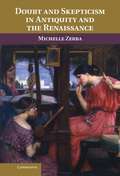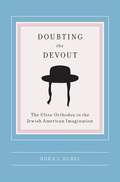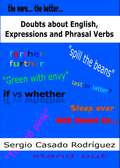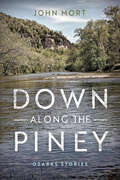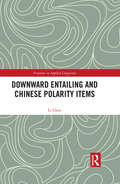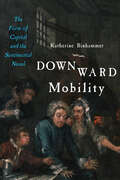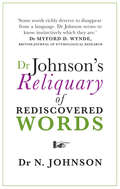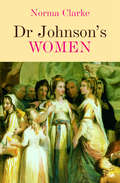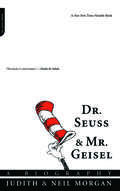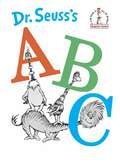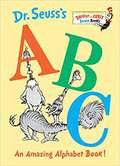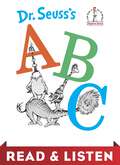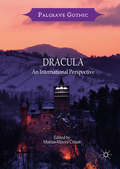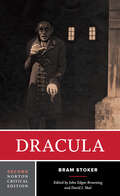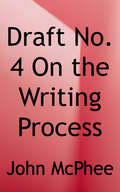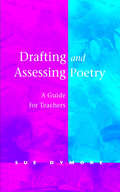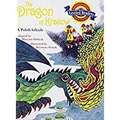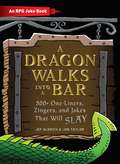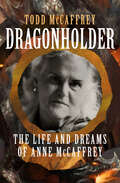- Table View
- List View
Doubt and Skepticism in Antiquity and the Renaissance
by Michelle ZerbaThis book is an interdisciplinary study of the forms and uses of doubt in works by Homer, Sophocles, Aristophanes, Cicero, Machiavelli, Shakespeare, and Montaigne. Based on close analysis of literary and philosophical texts by these important authors, Michelle Zerba argues that doubt is a defining experience in antiquity and the Renaissance, one that constantly challenges the limits of thought and representation. The wide-ranging discussion considers issues that run the gamut from tragic loss to comic bombast, from psychological collapse to skeptical dexterity, and from solitary reflection to political improvisation in civic contexts and puts Greek and Roman treatments of doubt into dialogue not only with sixteenth-century texts, but with contemporary works as well. Using the past to engage questions of vital concern to our time, Zerba demonstrates that although doubt sometimes has destructive consequences, it can also be conducive to tolerance, discovery, and conversation across sociopolitical boundaries.
Doubting the Devout: The Ultra-Orthodox in the Jewish American Imagination (Religion and American Culture)
by Nora L RubelBefore 1985, depictions of ultra-Orthodox Jews in popular American culture were rare, and if they did appear, in films such as Fiddler on the Roof or within the novels of Chaim Potok, they evoked a nostalgic vision of Old World tradition. Yet the ordination of women into positions of religious leadership and other controversial issues have sparked an increasingly visible and voluble culture war between America's ultra-Orthodox and non-Orthodox Jews, one that has found a particularly creative voice in literature, media, and film.Unpacking the work of Allegra Goodman, Tova Mirvis, Pearl Abraham, Erich Segal, Anne Roiphe, and others, as well as television shows and films such as A Price Above Rubies, Nora L. Rubel investigates the choices non-haredi Jews have made as they represent the character and characters of ultra-Orthodox Jews. In these artistic and aesthetic acts, Rubel recasts the war over gender and family and the anxieties over acculturation, Americanization, and continuity. More than just a study of Jewishness and Jewish self-consciousness, Doubting the Devout will speak to any reader who has struggled to balance religion, family, and culture.
Doubting the Devout: The Ultra-Orthodox in the Jewish American Imagination
by Nora L. RubelBefore 1985, depictions of ultra-Orthodox Jews in popular American culture were rare, and if they did appear, in films such as Fiddler on the Roof or within the novels of Chaim Potok, they evoked a nostalgic vision of Old World tradition. Yet the ordination of women into positions of religious leadership and other controversial issues have sparked an increasingly visible and voluble culture war between America's ultra-Orthodox and non-Orthodox Jews, one that has found a particularly creative voice in literature, media, and film. Unpacking the work of Allegra Goodman, Tova Mirvis, Pearl Abraham, Erich Segal, Anne Roiphe, and others, as well as television shows and films such as A Price Above Rubies, Nora L. Rubel investigates the choices non-haredi Jews have made as they represent the character and characters of ultra-Orthodox Jews. In these artistic and aesthetic acts, Rubel recasts the war over gender and family and the anxieties over acculturation, Americanization, and continuity. More than just a study of Jewishness and Jewish self-consciousness, Doubting the Devout will speak to any reader who has struggled to balance religion, family, and culture.
Doubts about English, Expressions and Phrasal Verbs
by Sergio Casado RodríguezIntroduction I like quick and simple explanations as you will appreciate. Especially when it comes to grammatical issues, in spite of the fact that there may be cases when one has to extend things a little further. I believe that things are learned little by little, and in studying foreign languages it is better to learn a more reduced usage of concepts and then widen it with the passing of time. I was always against having to study a mountain of rules from start to finish, then when the time comes to use them the rules are not going to be useful to me because I don't have a good command of the language. In the first part of the book I have compiled 29 doubts that my students frequently bring up to me, or that I have had myself. The 29 are going to be of great help because they come up frequently when it comes time to use them in conversation as well as when it is time to take an exam. Regarding the number of English expressions that I have chosen, I have noted a number of them that I feel are adequate, without being excessive or lacking. It is common to see the success of those posts or videos that have 400 phrasal verbs, but let's be honest. Not only will it be that no one is going to memorize those phrasal verbs, but there will be few people that will get to read them all.
Down Along the Piney: Ozarks Stories (Richard Sullivan Prize In Short Fiction Ser.)
by John MortDown Along the Piney is John Mort’s fourth short-story collection and winner of the Richard Sullivan Prize in Short Fiction. With settings in Florida, California, Mexico, Chicago, the Texas Panhandle, and, of course, the Ozarks themselves, these thirteen stories portray the unsung, amusing, brutal, forever hopeful lives of ordinary people. Mort chronicles the struggles of "flyover" people who live not just in the Midwest, but anywhere you can find a farm, small town, or river winding through forested hills. Mort, whose earlier stories have appeared in the New Yorker, GQ, and The Chicago Tribune, is the author of the award-winning Vietnam War novel Soldier in Paradise, as well as Goat Boy of the Ozarks and The Illegal. These ironic, unflaggingly honest stories will remind the reader of Jim Harrison, Sherwood Anderson, and Shirley Jackson.
Down in My Heart, Second Edition
by William Stafford(From the back cover) "Down in My Heart has an autobiographical dimension, a shy but brave sense of quest, of inner evolution, of maturation and growth from eager idealism at the beginning to ironic wariness verging on disillusionment at the close, that was so telling a measure for all of us who shared the CO experience. But. Stafford registers a feeling of absolute integrity within a situation of social alienation that is extraordinary, the more so because it is unconscious, emerging as the subsumed virtue of the work. In the quiet immediacy of his prose the future poet is alive and breathing. All in all, a perceptive glimpse into a most painful interval of our national life." --William Everson From 1940 to 1944, William Stafford was interned in the camps for conscientious objectors in the United States. As a pacifist, he worked for the Civilian Public Service on forest and soil conservation projects in Arkansas, California, and Illinois. As a writer, he recorded the life he found there; the fellowship within the camps and the antagonism outside them. Down in My Heart is an account of the relationships among the people in the camps, their day-to-day activities: fighting forest fires, building roads, terracing eroded lands, and their earnest pursuit of a social morality rooted in religious and secular pacifist ideals. Since then, William Stafford has published several collections of poetry, and he has published his views on the writer's vocation. He has been the Poetry Consultant for the Library of Congress, and received the highest praise as a poet and an educator. His awards include the National Book Award, the Shelley Memorial Award, and the American Academy and Institute of Arts and Letters Award in Literature.
Down on the Ranch
by Ellen Leigh Aleksey IvanovThe fun and excitement of English and Language Arts learning continues in Grade 2 of Reading Street. This comprehensive and dynamic curriculum for homeschooling is geared toward young children who have some foundational English and Language Arts knowledge and are ready to strengthen their skills. Comprised of engaging activities, challenging content and weekly quizzes, Reading Street: Grade 2 is the next step in your child's path toward becoming a lifelong learner and reader. As with all Reading Street products, the Grade 2 system is formatted to help students meet certain age-appropriate goals. After completing this English and Language Arts homeschool program, your child should be able to: Read and comprehend two-syllable words. Identify common prefixes (such as pre-, un-, or re-) and suffixes (such as -able, -ad and -er). Correct mistakes made when reading out loud. Read books with two or more chapters. Understand the structure of stores (i. e. beginning, middle and end). Start selecting reading materials based on his/her own interests. Identify the "who," "what," "when," "where," "why" and "how" of the text. While the goals of second Grade English and Language Arts are numerous, Reading Street will help you craft engrossing lessons. Your child will garner important English and Language Arts skills while completing a workbook, reading stories and poems, and taking assessments. Planning these lessons will be easier than ever, as all Reading Street systems are broken down into weekly Big Ideas. All the work your child does on a given week is formulated around that single concept for an organized and challenging curriculum. With six easy-to-follow units, Reading Street: Grade 2 is the perfect tool for homeschooling parents. Your child will enjoy the reading selections and activities, and you'll love to see your student growing into a knowledgeable individual. We're confident that this product is the right one for you. For more information on the specific materials found in Grade 2 of Reading Street, check out the Features and Benefits page.
Downward Entailing and Chinese Polarity Items (Frontiers in Applied Linguistics)
by Li ChenPolarity phenomena are pervasively observed in natural languages. Previous studies on Chinese polarity items are mainly in line with the non-veridicality approach. This book, however, employs the downward-entailing hypothesis as its analytical foundation, and argues that downward entailment is the only licensor for different kinds of Chinese polarity items, and non-veridicality is neither a necessary nor sufficient condition and thus offers inferior explanatory power compared with the former. To begin with, it lays the groundwork for this research by presenting a brief introduction to polarity phenomena and reviewing the existing relevant theories. Then it addresses the status of the commonly used element dou in Chinese. Specifically, it applies the tripartite structural frame to the studies of dou, and examines the role of dou in licensing the polarity items. Moreover, it investigates the properties and behavior of dou with respect to modality. Based on the analysis above, it observes that non-interrogative wh-indeterminates in Chinese can be licensed in the restriction domain of a necessity operator. Also, the non-uniformity of three Chinese polarity items, i.e., shenme, na-CL, and renhe, is scrutinized within the downward-entailing framework. This book will appeal to scholars, teachers and students in the field of linguistics, especially in the areas of formal semantics and generative grammar. Researchers and engineers in cloud computing and big data who are seeking help from linguistic contributions to meaning and logic will also benefit from it.
Downward Mobility: The Form of Capital and the Sentimental Novel
by Katherine BinhammerHow do the stories we tell about money shape our economies?Beginning in the late eighteenth century, as constant growth became the economic norm throughout Europe, fictional stories involving money were overwhelmingly about loss. Novel after novel tells the tale of bankruptcy and financial failure, of people losing everything and ending up in debtor's prison, of inheritances lost and daughters left orphaned and poor. In Downward Mobility, Katherine Binhammer argues that these stories of ruin are not simple tales about the losers of capitalism but narratives that help manage speculation of capital's inevitable collapse.Bringing together contemporary critical finance studies with eighteenth-century literary history, Binhammer demonstrates the centrality of the myth of downward mobility to the cultural history of capitalism—and to the emergence of the novel in Britain. Deftly weaving economic history and formal analysis, Binhammer reveals how capitalism requires the novel's complex techniques to render infinite economic growth imaginable. She also explains why the novel's signature formal developments owe their narrative dynamics to the contradictions within capital's form. Combining new archival research on the history of debt with original readings of sentimental novels, including Frances Burney's Cecilia and Camilla, Sarah Fielding's David Simple, and Oliver Goldsmith's The Vicar of Wakefield, Downward Mobility registers the value of literary narrative in interpreting the complex sequences behind financial capitalism, especially the belief in infinite growth that has led to current environmental crises. An audacious epilogue arms humanists with the argument that, in order to save the planet from unsustainable growth, we need to read more novels.
Dr. Johnson and Mr. Savage
by Richard Holmes"Dr. Johnson & Mr. Savage" recounts a story of a mysterious eighteenth-century friendship between Richard Savage -- poet, playwright, and convicted murderer -- and the young Samuel Johnson, an unknown provincial schoolmaster just arrived in London to seek his literary fortune. Holmes shows how the bond between Savage and Johnson revolutionized the art of biography.
Dr Johnson's Reliquary of Rediscovered Words
by Dr Neil JohnsonIn these pages you will discover words you never knew existed, and rediscover many that you had forgotten or had given up all hope of ever seeing again.If the amoindering of our language by fifish chuffs leads you to fleer and the infandous overslipping of orthoepy makes you feel wamble, this is most certainly the book for you.Prepare to fike, gane and gaure as Dr Johnson certiorates, carrying carotic catachresis to new heights, and providing all lovers of leguleian lexicographical detail with a rich feast of mullock, cultch and peltry.
Dr Johnson's Women
by Norma ClarkeDr Johnson's friendships with the leading women writers of the day was an important feature of his life and theirs. He was willing to treat women as intellectual equals and to promote their careers: something ignored by his main biographer, James Boswell. Dr Johnson's Women investigates the lives and writings of six leading female authors Johnson knew well: Elizabeth Carter, Charlotte Lennox, Elizabeth Montagu, Hester Thrale, Hannah More and Fanny Burney. It explores their relationships with Johnson, with each other and with the world of letters. It shows what it was like to be a woman writer in the 'Age of Johnson'. It is often assumed that women writers in the eighteenth century suffered the same restrictions and obstacles that confronted their Victorian successors. Norma Clarke shows that this was by no means the case. Highlighting the opportunities available to women of talent in the eighteenth century, Dr Johnson's Women makes clear just how impressive and varied their achievements were.
Dr. Seuss & Mr. Geisel: A Biography
by Judith Morgan Neil MorganHorton, Thidwick, Yertle, the Lorax, the Grinch, Sneetches, and the Cat in the Hat are just a handful of the bizarre and beloved characters Theodor S. Geisel (1904#150;1991), alias Dr. Seuss, created in his forty-seven children's books, from 1937's And to Think That I Saw It on Mulberry Street to 1990's Oh, the Places You'll Go! During his lifetime Dr. Seuss was honored with numerous degrees, three Academy Awards, and a Pulitzer, but the man himself remained a reclusive enigma. In this first and only biography of the good doctor, the authors, his close friends for almost thirty years, have drawn on their firsthand insights as well as his voluminous papers; the result is an illuminating, intimate portrait of a dreamer who saw the world "through the wrong end of a telescope," and invited us to enjoy the view.
Dr. Seuss's ABC (Beginner Books(R))
by Dr. SeussArguably the most entertaining alphabet book ever written, this classic Beginner Book by Dr. Seuss is perfect for children learning their ABCs. Featuring a fantastic cast of zany characters—from Aunt Annie&’s alligator to the Zizzer-Zazzer-Zuzz, with a lazy lion licking a lollipop and an ostrich oiling an orange owl—Dr. Seuss&’s ABC is a must-have for every young child&’s library. Originally created by Dr. Seuss, Beginner Books encourage children to read all by themselves, with simple words and illustrations that give clues to their meaning.
Dr. Seuss's ABC: Read & Listen Edition (Beginner Books(R))
by Dr. SeussArguably the most entertaining alphabet book ever written, this classic Beginner Book by Dr. Seuss is perfect for children learning their ABCs. Featuring a fantastic cast of zany characters—from Aunt Annie&’s alligator to the Zizzer-Zazzer-Zuzz, with a lazy lion licking a lollipop and an ostrich oiling an orange owl—Dr. Seuss&’s ABC is a must-have for every young child&’s library.Originally created by Dr. Seuss, Beginner Books encourage children to read all by themselves, with simple words and illustrations that give clues to their meaning.This Read & Listen edition contains audio narration.
Dracula: An International Perspective (Palgrave Gothic)
by Marius-Mircea CrişanThis volume analyses the role of Bram Stoker’s Dracula and its sequels in the evolution of the Gothic. As well as the transformation of the Gothic location—from castles, cemeteries and churches to the modern urban gothic—this volume explores the evolution of the undead considering a range of media from the 19th century protagonist to sympathetic contemporary vampires of teen Gothic. Based on an interdisciplinary approach (literature, tourism, and film), the book argues that the development of the Dracula myth is the result of complex international influences and cultural interactions. Offering a multifarious perspective, this volume is a reference work that will be useful to both academic and general readers.
Dracula (Norton Critical Editions #0)
by Bram Stoker“In Dracula, we find a monster who takes away our agency, our choice—even as he consumes us. The fantasy of becoming a vampire is a myth of exceptionalism— nobody fantasizes about being the random peasant whom the titular Count devours. Instead, people are thrilled by the thought of turning into vampires themselves—becoming the most powerful consumer, the apex predator. And until we recognize that we have far more in common with prey than predator, we will always feel the vampire's pull. I hope Norton's vital new addition to the conversation about Stoker’s work will cause readers to look at this old story with new eyes: to question our preconceptions and refocus our own narrative lenses. Dracula remains evergreen, I'm afraid—because within our monsters... we may find ourselves.” —Kate Hamill (playwright/actor) This Norton Critical Edition includes: The first edition of the novel, published by Archibald Constable in London in 1897 and chosen by the editors in order to give readers—insofar as such a thing is possible—a more historically authentic reading experience than has been generally available. Arcane words and usages are footnoted at first appearance. Editorial matter by John Edgar Browning and David J. Skal. Eight background pieces, five of them new to the Second Edition, on Count Dracula specifically and vampires more generally; seven reviews and reactions to Dracula’s publication, five of them new to the Second Edition; and six selections, two of them new to and two others updated for the Second Edition, on Dracula’s many dramatic and filmic variations. Eleven critical essays on Dracula’s central themes, six of them new to the Second Edition. A selected bibliography. About the Series? Read by more than 12 million students over fifty-five years, Norton Critical Editions set the standard for apparatus that is right for undergraduate readers. The three-part format—annotated text, contexts, and criticism—helps students to better understand, analyze, and appreciate the literature, while opening a wide range of teaching possibilities for instructors. Whether in print or in digital format, Norton Critical Editions provide all the resources students need.? “The notes in Dracula are exactly at the right level for students. The headnotes are extremely helpful. It really does [meet the needs of today's students]. It is my favorite NCE to teach.” —Carrie D. Shanafelt, Fairleigh Dickinson University
Draft No. 4: On the Writing Process
by John McPheeDraft No. 4 is a master class on the writer's craft. In a series of playful, expertly wrought essays, John McPhee shares insights he has gathered over his career and has refined while teaching at Princeton University, where he has nurtured some of the most esteemed writers of recent decades. McPhee offers definitive guidance in the decisions regarding arrangement, diction, and tone that shape nonfiction pieces, and he presents extracts from his work, subjecting them to wry scrutiny. In one essay, he considers the delicate art of getting sources to tell you what they might not otherwise reveal. In another, he discusses how to use flashback to place a bear encounter in a travel narrative while observing that "readers are not supposed to notice the structure. It is meant to be about as visible as someone's bones." The result is a vivid depiction of the writing process, from reporting to drafting to revising--and revising, and revising. Draft No. 4 is enriched by multiple diagrams and by personal anecdotes and charming reflections on the life of a writer. McPhee describes his enduring relationships with The New Yorker and Farrar, Straus and Giroux, and recalls his early years at Time magazine. Throughout, Draft No. 4 is enlivened by his keen sense of writing as a way of being in the world.
Drafting and Assessing Poetry: A Guide for Teachers
by Sue Dymoke`This excellent book provides the reader with comprehensive coverage of all aspect of poetry teaching. The book does more than inform us - it inspires profound reflection on the best ways it support poetry writing and draws us into the debate about assessment-driven curriculum' - School Librarian `A must for trainee teachers and English departments' - Booktrusted News `Drafting and Assessing Poetry is thoroughly researched and shows how attitudes towards teaching of poetry and indeed the place of poetry on the syllabus, has changed with political fashion over the years, but more importantly, Sue Dymoke shows how a handful of contemporary poets go about drafting their work and sees this process as an essential tool in the classroom, advocating that students should keep drafting notebooks, just like real writers. Getting students, or indeed members of writing groups, to understand that one draft of a poem may not be the final or best work they can produce will never be a problem again!' - Writing in Education `Sue Dymoke's book is a much needed antidote to the ubiquitous guides to poetry analysis.... This book is well worth reading for its clarity and wealth of ideas' - Bethan Marshall, TES Teacher Magazine `Every English department should buy this remarkably comprehensive book. Inspiring approaches for teaching children to write poetry are clearly described. Sue Dymoke draws upon her extensive experience as a poet, English teacher and researcher to explore the place of writing poetry in English lessons and examinations. Her unique insights into both the writing and teaching of poetry should prove invaluable to English teachers' - Dr Mark Pike, Lecturer in English Education and Head of PGCE English, University of Leeds `It is a useful book: a theoretical text, but with a practical focus, which makes it very readable and interesting, to teachers of young people particularly, but also, to teachers of adults and indeed in parts to poetry writers themselves, particularly those interested in working in schools, or simply curious about the general process of drafting and evaluating poetry' - County Lit, Nottinghamshire County Council Literature Newsletter Drafting and Assessing Poetry offers a range of teaching strategies for developing students' poetry writing skills, and guidance about assessment approaches. Critical commentaries combine with illustrations of successful classroom practice to consider this essential but under-explored aspect of English teaching. Based on theory but with a practical dimension, the book engages readers in current critical debates about poetry teaching and its place in an assessment- driven curriculum. This book is for reflective practitioners, including trainee teachers, who want to develop their understanding of poetry teaching and to gain insights, which will inform classroom practice. It will also be useful for literacy co-ordinators, teacher educators and other advisory staff in the field of English teaching.
The Dragon Drawing War: Targeting r Blends (Speech Bubbles 2)
by Melissa PalmerThis is a tale of two brothers, duelling to become a dragon drawing champion. Great skill and imagination must be used to become the victor! If you don’t succeed today, do not fear. There will be another war to fight tomorrow. This picture book targets /r/ blends and is part of Speech Bubbles 2, a series of picture books that target specific speech sounds within the story. The series can be used for children receiving speech therapy, for children who have a speech sound delay/disorder, or simply as an activity for children’s speech sound development and/or phonological awareness. They are ideal for use by parents, teachers or caregivers. Bright pictures and a fun story create an engaging activity perfect for sound awareness. Picture books are sold individually, or in a pack. There are currently two packs available – Speech Bubbles 1 and Speech Bubbles 2. Please see further titles in the series for stories targeting other speech sounds.
The Dragon of Krakow: A Polish folktale [Grade 3]
by Maryann Dobeck Krystyna StasiakNIMAC-sourced textbook
A Dragon Walks Into a Bar: An RPG Joke Book
by Jef Aldrich Jon TaylorThis hilarious collection of over 300 puns, one-liners, and classic jokes dedicated to the fun of RPGs is perfect for you share with your fellow gaming compatriots!Why don&’t dragons like to eat paladins? They taste lawful. Laugh out loud at over 300 zingy one-liners and eye-rolling puns with this collection of tabletop-based humor, dedicated to the fun of RPGs like Dungeons and Dragons, Pathfinder, and more! A Dragon Walks into a Bar gives you hours of funny content that will keep you smiling. Whether you use them as inspiration for your level 20 comedian bard to crack wise during battle or if you just want a giggle in between turns, this book has everything you&’ve been looking for.
Dragonholder: The Life and Dreams of Anne McCaffrey
by Todd McCaffreyAn enthralling biography of one of the most luminous shining stars of fantasy and science fiction, world builder and dragon master Anne McCaffrey, written by her son, collaborator, and most devoted fanWhile you&’ve been to Pern . . . you haven&’t heard the stories behind the stories. I propose to fix that. When Anne McCaffrey&’s Hugo Award–winning novella &“Weyr Search&” appeared in the late 1960s as part of the novel Dragonflight, the science fiction universe was gloriously transformed as readers first experienced the exhilarating thrill of soaring with dragons. With the many Pern novels that followed, McCaffrey steadily won the hearts and unwavering devotion of millions of fans, eventually earning a permanent position on the New York Times bestseller list. Dragonholder celebrates the birth and growth of McCaffrey&’s breathtaking literary vision, as well as the momentous events of a life that was in many ways as extraordinary as the worlds and characters that McCaffrey created. No one understands or appreciates McCaffrey&’s life and work better than her son, Todd, does. In Dragonholder, her frequent coauthor and avid fan intimately examines his mother&’s childhood and early adulthood, the amazing gift of second sight she inherited from her own mother and grandmother, the trials she faced juggling a career and a family during the turbulent sixties, and her rise to literary stardom—and he reveals the events and influences that ultimately gave rise to the myriad wonders of Pern and the other miraculous worlds borne of Anne McCaffrey&’s unparalleled imagination.
